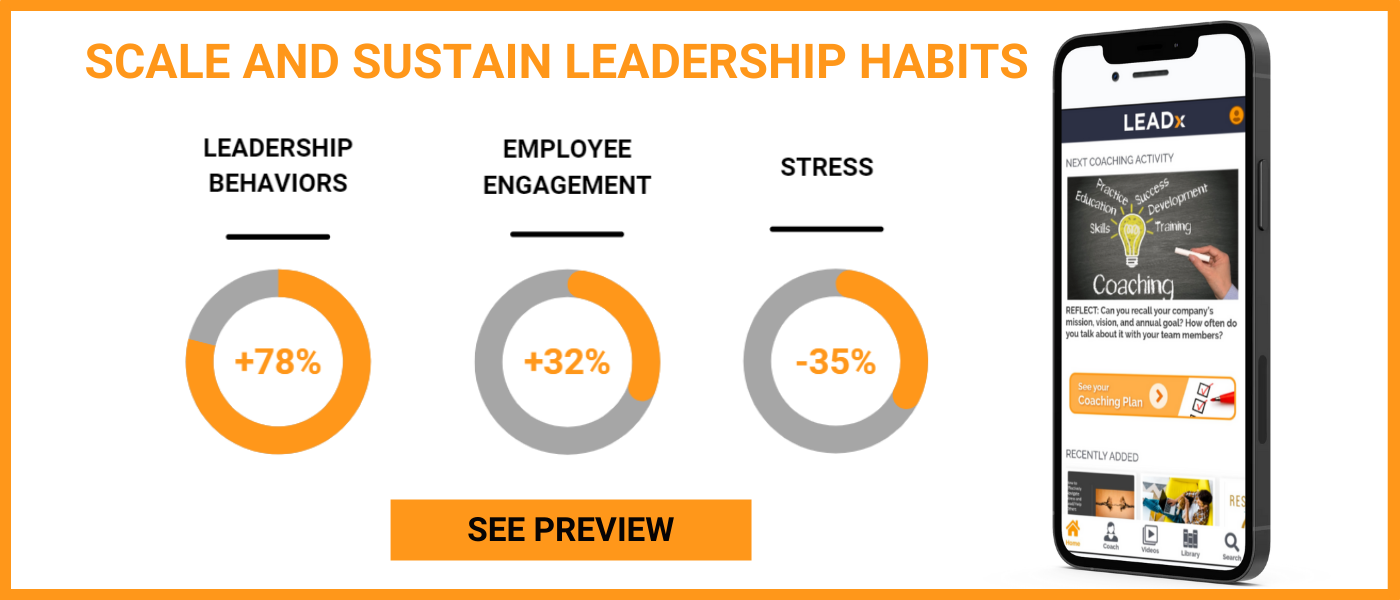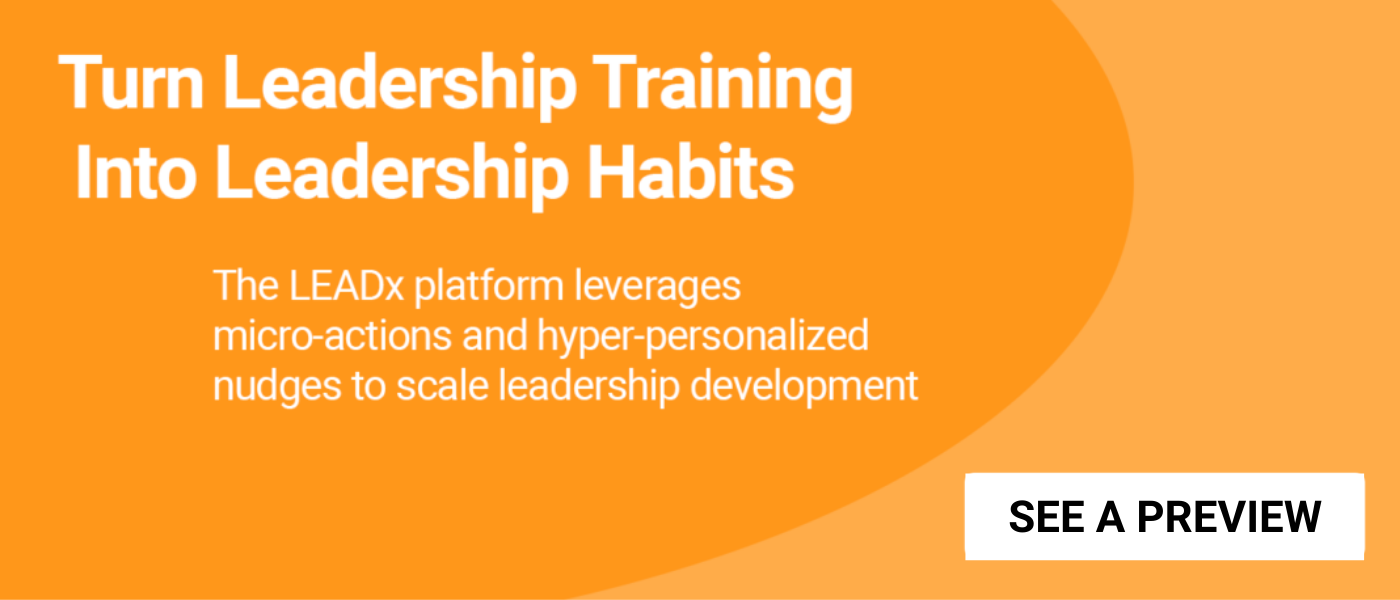
Leadership development used to be all about content: Curating content, planning out multi-day workshops to deliver content, and measuring success by how many people received your content (attendance and course completion).
This all began to change as smartphones took off. Once people could learn “how to resolve conflict” on TikTok and watch tutorials on “delegation” on YouTube, the premium on content curation shrank. Instead, the best leadership development professionals started to double down on the metric they knew mattered most: Behavior Change.
 Behavior change, after all, is the key to improving employee experience, the key to building a high-performing team, and the key to shaping a healthy culture. Simply put, behavior change is the one and only path to a return on investment.
Behavior change, after all, is the key to improving employee experience, the key to building a high-performing team, and the key to shaping a healthy culture. Simply put, behavior change is the one and only path to a return on investment.
How The Shift to Behavior Change Happened
Of course, the goal of leadership development has always been to instigate behavior change. The problem was that for decades, L&D professionals had to spend their time packaging together and delivering the content their learners needed to learn to succeed. With their time and resources devoted to content, they then lacked the tools, technology, and resources to fully invest in pulling that learning through.
By the time the tools, technology, and resources caught up, the industry was entrenched in its old way of doing things. When behavior didn’t improve, L&D professionals doubled and tripled down on improving the content. Tunnel vision prevented them from zooming out and seeing the better way forward.
To help shift your perspective toward behavior change, you have to stop thinking of yourself as a “content curator” and your team as a “content delivery service.” Instead, think of yourself as a “guide on the side.” A “guide on the side” recognizes that most of the content managers need is available and that the majority of their time, effort, and budget should be spent on what truly matters: helping leaders build new habits.
Here are three valuable ways to shift from a “content curator” to a “guide on the side.”
Three Ways to Drive Behavior Change in Your Training Program
#1 – Leverage the 3-to-1 Learning Model. The 3-to-1 Learning Model is simple and actionable, but it represents a big shift away from content-driven leadership development. It states that, for each formal learning, you should design and facilitate three on-the-job application exercises. The 3-to-1 ratio goes for budget and time, too. If, for example, you have $40,000 to spend on a program, you would spend $10,000 on training and $30,000 on habit-building activities. And if you have four hours of leaders’ time, only one hour should be devoted to a traditional training session, with three hours going toward application exercises.
Consider “effective feedback” training for managers as an example. Following the 3-to-1 model, the training program might look like the following:
- A live workshop to learn and practice a feedback framework like the B.I.G. model (Behavior, Impact, Get Agreement).
- A peer learning session where participants role-play feedback conversations.
- Each participant practices feedback by giving their team members positive feedback only.
- Each participant practices giving constructive feedback in a lower-stakes conversation.
#2 – Take a Coach Approach. No one bridges the gap between knowledge and action better than executive coaches. After all, their success hinges on helping leaders change their behavior. To help their coachees build new habits, coaches pull from a repertoire of proven activities and exercises. You can apply many of the same approaches that executive coaches use on a bigger scale—in your training programs.
To come up with the application exercises the 3-to-1 model requires, look no further than a coach’s toolbox:
- Commitment exercises: Leaders discuss, journal, or sign a contract about what they hope to gain from training and how they plan to overcome obstacles.
- Self-Awareness: Ask your leaders to think about and reflect on why they act the way they do, specifically in the context of your training. The idea is to cultivate self-awareness around potentially limiting mindsets and beliefs.
- Assessments: Done either by peers or the leaders themselves, assessment can provide critical insights about blindspots and weaknesses.
- Practice: Often, applying a new concept (i.e., the 8-step Kotter model) can be intimidating. Provide low-stakes practice opportunities like role-play and workshops to “ease in” to application.
- Social Support: Social support helps inspire action. Leverage cohort-based learning, peer learning networks, group coaching sessions, and learn-teach activities.
- Schedule it: Encourage leaders to proactively schedule on-the-job application of learning. For example, ask leaders to schedule fifteen minutes every Friday to “write a note of recognition.”
- Reflection: Provide thoughtful post-training reflection and journaling exercises that help learners devise a long-term action plan to practice and improve.
#3 – Put Learning into the Flow of Work. By delivering content into the natural flow of work, you enable learners to consume content in short bursts that fit more easily into their schedules. This way, you don’t have to pull learners away from their work for a long period of time. To act as a behavior change guide, consider implementing the following tech tools into your learning and development programs:
- Micro-learning: Small, easy-to-digest pieces of content that are accessible on-demand. The most effective micro-learning content takes between two and five minutes to consume, so this could include short videos, articles, book summaries, and podcast excerpts.
- Nudges: Little reminders to consume or apply learnings that help leaders build new habits. “Nudges” can take the form of push notifications, text messages, or email reminders. For example, if a leader is learning how to give effective feedback, a “nudge” may serve to remind her to “deliver constructive feedback with compliments on either end for Nikita, who’s high in conscientiousness.”
- On-demand coaching: “Office hour” style coaching. The ability to text or live chat with an expert coach helps deepen learning by grounding it in day-to-day work and challenges. And, instead of having to wait until their next scheduled session, learners can submit questions about a challenge or speedbump in their learning as it comes up.
Focusing on Behavior Change Is A Competitive Advantage for Leadership Development Professionals
Winning a seat at the table, earning more budget, and producing measurable results all boil down to a leadership development professional’s ability to help leaders change their behavior. Those who have started to shift their focus, their budget, and their approach to be agents of behavior change are setting themselves up to have a competitive advantage.






